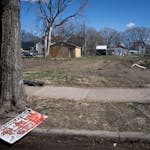Like many people in his 60s, Larry Windom recently found himself sifting through his late parents' stuff. He plucked a silver token from a black coin pouch tucked among the jelly jars of odds and ends his folks left behind in their west-central Minnesota home in Elbow Lake.
That quarter-sized clue led to a largely forgotten, bar-owning philanthropist whose story resonates especially around Thanksgiving.
Emblazoned on the token were two words: "Tooze's Minneapolis." A quick internet search introduced Windom to the remarkable life arc of John "Tooze" Rogers — who climbed from cash-strapped hotel bellhop in 1880 to own a series of saloons, theaters and an elegant Nicollet Avenue hotel bearing his name in Minneapolis.
The faded token even included a pronunciation guide more than a century old. The double-Z trademark inside a diamond reminded everyone his bar name sounded like "two Zs" and didn't rhyme with booze — which Rogers sold pre-Prohibition but never drank.
The second of six siblings, John Edward Rogers was born Sept. 21, 1869, in the central Illinois town of Sulphur Springs. His father, a onetime preacher, nicknamed his son "Tooze" as a baby just as the family moved to an Olmsted County farm between Rochester and Winona.
For much of his first 15 years, Rogers walked with a crutch because of chronic ankle swelling he later outgrew. He left the farm at 20 — first landing a bellhop job at a Lake Minnetonka hotel and soon securing a growing role at the Little Mint saloon in Minneapolis.
He invested $4,800 of his early profits into land speculation near Hibbing, a disastrous move that left him with $275 when he returned to Minneapolis and resurrected his career.
By the time he died following intestinal surgery in 1912, at just 42, Rogers' empire included 11 enterprises, land in Mexico, mining interests and a chicken ranch.
"He was a man gifted with concentration who could ... keep a dozen plans going like a sleight-of-hand performer keeping a dozen plates in a row spinning at the same time," one reporter said after he died. "He never seemed to worry."
More than anything, Rogers became known as the unofficial patron saint of the newsies and shoeshine boys who hustled for coins on Minneapolis street corners around 1900. Every Thanksgiving from 1906 until his after his death, Rogers and his wife, Mae, threw lavish feasts for the poor street urchins in a tradition that grew to feed more 700 kids.
One newspaper account described four boys lining up at dawn around the block of the Rogers Hotel for Thanksgiving turkey: "One was colored, another was a cripple, one of the others was redheaded and the fourth was a little Jewish boy. They were typical of the boyhood Tooze Rogers had always befriended."
The Thanksgiving banquets continued 15 years after Rogers' death, thanks to a tiny Romanian immigrant known as "Shorty" Schwartz — who went from newsboy to manage the Rogers Hotel cafe. Schwartz said Tooze once told him: "If I ever get old and doddering or die, you'll have to feed the boys, Shorty."
Profit-sharing with his employees and weekly meetings to solicit their suggestions helped galvanize loyalty. "I get the chambermaids together and talk to them until they care for rooms as I would have done," he once said. "I do the same with the waiters."
More than 200 of those faithful workers attended Rogers' memorial service at his Unique Theater on Hennepin Avenue, where the Rev. G.L. Morrill recalled how "Tooze" freely opened the theater for Sunday religious services that welcomed "all creeds, religious beliefs and nationalities."
When a newsboy was found weeping on the streets after Rogers died, he explained: "Don't you know 'Tooze' was a swell man?" The eulogizing preacher said that simple tribute was worth more than "all the words of eloquence that could come from the pulpit."
Rogers was buried at Lakewood Cemetery in Minneapolis. He and his wife had no children and, after his death, his siblings and widow became locked in lawsuits over his fortune. The Rogers Hotel was sold in 1936 and razed in 1960.
But that silver Tooze's token lives on.
"God only knows where my dad got it," said Windom, 66, who lives in Buffalo, Minn. His father, Orlin, was born in 1919 — seven years after Tooze died.
The token might have belonged to his grandfather, Oscar, the son of Norwegian émigrés who moved via ox cart from Wisconsin to Elbow Lake when Orlin was a boy.
"My dad remembers going through Minneapolis as a kid and losing his dog," Windom said. "Maybe that's when his father wound up with the Tooze's token."
Curt Brown's tales about Minnesota's history appear each Sunday. Readers can send him ideas and suggestions at mnhistory@startribune.com. His latest book looks at 1918 Minnesota, when flu, war and fires converged: http://strib.mn/MN1918.




